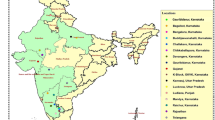Abstract
Thirty-four isolates ofFusarium oxysporum f.sp.melonis (F.o.m.) obtained from 205 fields in melon-producing areas in the southeastern Anatolia Region of Turkey were identified on the basis of colony morphology and pathogenicity by the root dip method. In this region the mean prevalence of wilt disease was 88.1% and the mean incidence of disease was 47.5%. Physiologic races 0, 1, 2, and 1,2 of the pathogen were determined by their reactions on differential melon cultivars ‘Charentais T,’ ‘Isoblon’, ‘Isovac’ and ‘Margot’ in the greenhouse. Race 1,2, representating 58.8% (20/34) of all isolates, was widely distributed. Of the other pathogenic isolates, eight were identified as race 0, five as race 1, and one as race 2. This is the first report of physiologic races ofF.o.m. in Turkey. Of 44 melon cultivars tested in the greenhouse for resistance toF.o.m. races, 36 were found to be moderately resistant to race 0, 17 were susceptible to race 1,2, 34.1% were highly resistant to race 1, and 52.2% had moderate resistance to race 2.
Similar content being viewed by others
References
Abou-Jawdah, Y. and Al-Khoury, A.M. (1996) First report on the identification of races 0, 1, and 1, 2 ofF.o.m. in Lebanon.Plant Dis. 80:711.
Anon. (1999) Agricultural Structure and Production. DIE Publications, No. 1727. Ankara, Turkey.
Barnes G.L. (1972) Differential pathogenicity ofFusarium oxysporum f.sp.niveum to certain wilt-resistant cultivars.Plant Dis. Rep. 56:1022–1026.
Bicici, M. and Kurt, S. (1998) Etiology, incidence and prevalence of cotton wilt disease and strains of the wilt pathogen in Cukurova.Proc. 2nd World Cotton Research Conf., New Frontiers in Cotton Research (Athens, Greece), Vol. II, pp. 914–918.
Bouhot, D. (1981) Some aspects of the pathogenic potential in Formae speciales and races ofFusarium oxysporum on Cucurbitaceae. pp. 318–326.in: Nelson, P.E., Toussoun, T.A. and Cook, R.J. [Eds.] Fusarium: Diseases, Biology and Taxonomy. The Pennsylvania State University Press, University Park, PA, USA.
Cohen, R., Katan, T., Katan, J. and Cohn, R. (1989) Occurrence ofFusarium oxysporum f.sp.melonis race 1,2 on muskmelon in Israel.Phytoparasitica 17:319–322.
Cohen, R., Riov, J., Lisker, N. and Katan, J. (1986) Involvement of ethylene in herbicide-induced resistance toFusarium oxysporum f.sp.melonis.Phytopathology 76:1281–1285.
Cohen, R., Yarden, O., Katan, J., Riov, J. and Lisker, N. (1987) Paclobutrazol and other plant growth-retarding chemicals increase resistance of melon seedlings to Fusarium wilt.Plant Pathol. 36:558–564.
Erzurum, K., Taner, Y., Secer, E., Yanmaz, R. and Maden, S. (1999) Occurrence of races ofFusarium oxysporum f.sp.melonis causing wilt on melon in Central Anatolia.J. Turk. Phytopathol. 28:87–97.
Jacobson, D.J. and Gordon, T.R. (1991)Fusarium oxysporum f.sp.melonis: A case study of diversity within aforma specialis.Phytopathology 81:1064–1067.
Katan, T., Katan, J., Gordon, T.R. and Pozniak, D. (1994) Physiologic races and vegetative compatibility groups ofF.o.m. in Israel.Phytopathology 84:153–157.
Martyn, R.D. and Gordon, T.R. (1996) Fusarium wilt of melon. pp. 14–15.in: Zitter, T.A., Hopkins, D.L. and Thomas, C.D. [Eds.] Compendium of Cucurbit Diseases. American Phytopathological Society, St. Paul, MN, USA.
Nelson, P.E., Toussoun, T.A., Burgess, L.W., Mararas, W.F.O. and Liddell, C.M. (1986) Isolating, identifying and producing inoculum of pathogenic species ofFusarium.in: Hickey, K.D. [Ed.] Methods for Evaluating Pesticides for Control of Plant Pathogens. APS Press, St. Paul, MN, USA.
Pitrat, M. (1998) Gene list for melon.Cucurbit Genet. Coop. Rep. 21:69–81.
Risser, G., Banihashemi, Z. and Davis, D.W. (1976) A proposed nomenclature ofFusarium oxysporum f.sp.melonis races and resistance genes inCucumis melo.Phytopathology 66:1105–1106.
Schreuder, W., Lamprecht, S.C. and Holz, G. (2000) Race determination and vegetative compatibility grouping ofFusarium oxysporum f.sp.melonis from South Africa.Plant Dis. 84:231–234.
Yücel, S., Pala, H., Sarı, N. and Abak, K. (1994) Determination ofFusarium oxysporum f.sp.melonis races in the East Mediterranean Region of Turkey and response of some melon genotypes to the disease.Proc. 9th Congr. Mediterranean Phytopathological Union. Turkish Phytopathological Society Publications No. 7, pp. 87–89. Kuşadası, Aydın, Turkey.
Zink, F.W. and Gubler, W.D. (1986) Inheritance of resistance to races 0 and 2 ofFusarium oxysporum f.sp.melonis in gynoecious muskmelon.Plant Dis. 70:676–678.
Zink, F.W., Gubler, W.D. and Grogan, R.G. (1983) Reaction of muskmelon germ plasm to inoculation withFusarium oxysporum f.sp.melonis race 2.Plant Dis. 67:1251–1255.
Zuniga, T.L., Zitter, T.A., Gordon, T.R., Schroeder, D.T. and Okamoto, D. (1997) Characterization of pathogenic races ofFusarium oxysporum f.sp.melonis causing Fusarium wilt of melon in New York.Plant Dis. 81:592–596.
Author information
Authors and Affiliations
Corresponding author
Additional information
http://www.phytoparasitica.org posting July 16, 2002.
Rights and permissions
About this article
Cite this article
Kurt, S., Baran, B., Sarı, N. et al. Physiologic races ofFusarium oxysporum f.sp.melonis in the southeastern anatolia region of turkey and varietal reactions to races of the pathogen. Phytoparasitica 30, 395–402 (2002). https://doi.org/10.1007/BF02979687
Received:
Revised:
Issue Date:
DOI: https://doi.org/10.1007/BF02979687




